Bell X-1 Video - Historical overview
|
|

Picture - X-1 #46-062, nicknamed "Glamorous Glennis"
Role: rocket plane, Experimental Aircraft
Manufacturer: Bell Aircraft
First flight: 19 January 1946
Status: Retired
Primary users: United States Air Force
National Advisory Committee for Aeronautics
The Bell X-1, originally designated XS-1, was a joint NACA-U.S. Army Air Forces/US Air Force supersonic research project and the first aircraft to exceed the speed of sound in controlled, level flight. This resulted in the first of the so-called X-planes, an American series of experimental aircraft designated for testing of new technologies and usually kept highly secret.
Design and development
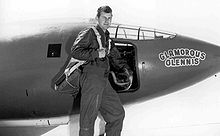
Picture - Chuck Yeager in front of the X-1, which he named Glamorous Glennis after his wife.
On 16 March 1945, the United States Army Air Forces' Flight Test Division and the National Advisory Committee for Aeronautics (NACA) (now NASA) contracted Bell Aircraft to build three XS-1 (for "Experimental, Supersonic", later X-1) aircraft to obtain flight data on conditions in the transonic speed range. The XS-1 was the first high-speed aircraft built purely for aviation research purposes and was never intended for production.
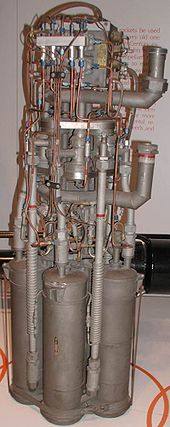
Picture - XLR-11 rocket engine
The X-1 was in principle a "bullet with wings" that closely resembled the shape of the Browning .50-caliber (12.7 mm) machine gun bullet that was known to be stable in supersonic flight. The pattern shape was followed to the point of seating the pilot behind a sloped, framed window inside a confined cockpit in the nose. After the aircraft ran into compressibility problems in 1947, it was modified to feature a variable-incidence tailplane. An all-moving tail was developed by the British for the Miles M.52, and first saw actual transonic flight on the Bell X-1 that allowed it to pass through the sound barrier safely.
The rocket propulsion system was a four-chamber engine built by Reaction Motors, Inc., one of the first companies to build liquid-propellant rocket engines in America. It burned ethyl alcohol diluted with water and liquid oxygen. The thrust could be changed in 1500 lbf increments by firing one or more of the chambers. The fuel and oxygen tanks for the first two X-1 engines were pressurized with nitrogen and the rest with steam-driven turbopumps. The all-important fuel turbopumps, necessary to raise the chamber pressure and thrust, while lightening the engine, were built by Robert Goddard who was under Navy contract to provide jet-assisted takeoff rockets.
Operational history
Bell Aircraft Chief Test Pilot, Jack Woolams became the first to fly the XS-1, in a glide flight over Pinecastle Army Airfield, in Florida, on 25 January 1946. Woolams would complete nine additional glide flights over Pinecastle before March 1946, when the #1 aircraft was returned to Bell for modifications in anticipation of the powered flight tests, planned for Muroc Army Air Field (now Edwards Air Force Base) in California. Following Woolams' death on 30 August 1946, Chalmers "Slick" Goodlin was the primary Bell Aircraft test pilot of X-1-1 (serial 46-062). He made 26 successful flights in both of the X-1 aircraft from September 1946 until June 1947.
The Army Air Force was unhappy with the cautious pace of flight envelope expansion and Bell Aircraft's flight test contract for aircraft #46-062 was terminated and was taken over by the Army Air Force Flight Test Division on 24 June after months of negotiation. Goodlin had demanded a US$150,000 bonus for breaking the sound barrier. Flight tests of the X-1-2 (serial 46-063) would be conducted by NACA to provide design data for later production high-performance aircraft.
On 14 October 1947, just under a month after the United States Air Force had been created as a separate service, the tests culminated in the first manned supersonic flight, piloted by Air Force Captain Charles "Chuck" Yeager in aircraft #46-062, which he had christened Glamorous Glennis after his wife. The rocket-powered aircraft was launched from the bomb bay of a specially modified B-29 and glided to a landing on a runway. XS-1 flight number 50 is the first one where the X-1 recorded supersonic flight, at Mach 1.06 (361 m/s, 1,299 km/h, 807.2 mph) peak speed; however, Yeager and many other personnel believe Flight #49 (also with Yeager piloting), which reached a top recorded speed of Mach 0.997 (339 m/s, 1,221 km/h), may have, in fact, exceeded Mach 1. (The measurements were not accurate to three significant figures and no sonic boom was recorded for that flight.)
As a result of the X-1's initial supersonic flight, the National Aeronautics Association voted its 1948 Collier Trophy to be shared by the three main participants in the program. Honored at the White House by President Harry S. Truman were Larry Bell for Bell Aircraft, Captain Yeager for piloting the flights, and John Stack for the NACA contributions.
On 5 January, 1949, Yeager used Aircraft #46-062 to carry out the only conventional (runway) take off performed during the X-1 program, reaching 23,000 ft in 90 seconds.
Legacy
The research techniques used in the X-1 program became the pattern for all subsequent X-craft projects. The NACA X-1 procedures and personnel also helped lay the foundation of America's space program in the 1960s. The X-1 project defined and solidified the post-war cooperative union between U.S. military needs, industrial capabilities, and research facilities. The flight data collected by the NACA in the X-1 tests then provided a basis for American aviation supremacy in the latter half of the 20th century.
Disposition
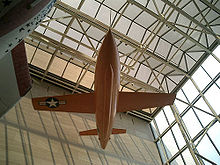
Picture - X-1 at the Smithsonian
Aircraft #46-062 is currently on display in the Milestones of Flight gallery of the National Air and Space Museum in Washington, DC, alongside the Spirit of St. Louis and SpaceShipOne. Aircraft #46-063, now the X-1E, is on display in front of the NASA Dryden Flight Research Center headquarters building.
Variants
Later variants of the X-1 were built to test different aspects of supersonic flight; one of these, the X-1A, with Yeager at the controls, inadvertently demonstrated a very dangerous characteristic of fast (Mach 2 plus) supersonic flight: inertia coupling. Only Yeager's skills as an aviator prevented him from dying that day; later Mel Apt would die testing the Bell X-2 under similar circumstances.
X-1A
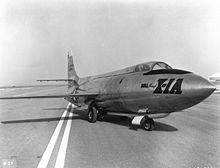
Picture - X-1A.
Ordered by the Air Force on 2 April 1948, the X-1A (serial 48-1384) was intended to investigate aerodynamic phenomena at speeds above Mach 2 (681 m/s, 2,451 km/h) and altitudes greater than 90,000 ft (27 km), specifically focusing on dynamic stability and air loads. Longer and heavier than the original X-1, with a bubble canopy for better vision, the X-1A was powered by the same Reaction Motors XLR-11 rocket engine. The aircraft first flew, unpowered, on 14 February 1953 at Edwards AFB, with the first powered flight on 21 February. Both flights were piloted by Bell test pilot Jean Ziegler.
After NACA started its high-speed testing with the Douglas Skyrocket, culminating in Scott Crossfield achieving Mach 2.005 on 20 November 1953, the Air Force started a series of tests with the X-1A, which the test pilot of the series, Chuck Yeager, named "Operation NACA Weep". These culminated on 12 December 1953, when Yeager achieved an altitude of 74,700 feet (22,770 m) and a new air speed record of Mach 2.44 (equal to 1620 mph, 724.5 m/s, 2608 km/h at that altitude). Unlike Crossfield in the Skyrocket, Yeager achieved that in level flight. Shortly after, the aircraft spun out of control, due to the then not yet understood phenomenon of inertia coupling. The X-1 dropped from maximum altitude to 25,000 feet (7,620 m), exposing the pilot to accelerations of up to 8g, during which Yeager broke the canopy with his helmet before regaining control.
The aircraft was transferred to NACA in September 1954. Following modifications, including the installation of an ejection seat, the aircraft was lost on 8 August 1955 while being prepared for launch from the RB-50 mothership, becoming the first of many early X-planes that would be lost to explosions.
X-1B
The X-1B (serial 48-1385) was equipped with aerodynamic heating instrumentation for thermal research (over 300 thermal probes were installed on its surface). It was similar to the X-1A except for having a slightly different wing. The X-1B was used for high speed research by the US Air Force starting from October 1954 prior to being turned over to the NACA in January 1955. NACA continued to fly the aircraft until January 1958 when cracks in the fuel tanks forced its grounding. The X-1B completed a total of 27 flights. A notable achievement was the installation of a system of small reaction rockets used for directional control, making the X-1B the first aircraft to fly with this sophisticated control system, later used in the X-15. The X-1B is now at the National Museum of the United States Air Force, Wright-Patterson Air Force Base at Dayton, Ohio, where it is displayed in the Museum's Research & Development Hanger.
X-1C
The X-1C (serial 48-1387) was intended to test armaments and munitions in the high transonic and supersonic flight regimes. It was canceled while still in the mock-up stage, as the birth of transonic and supersonic-capable aircraft like the North American F-86 Sabre and the North American F-100 Super Sabre eliminated the need for a dedicated experimental test platform.
X-1D
The X-1D (serial 48-1386) was the first of the second generation of supersonic rocket planes. Flown from an EB-50A (s/n #46-006), it was to be used for heat transfer research. The X-1D was equipped with a new low-pressure fuel system and a slightly increased fuel capacity. There were also some minor changes to the avionics set.
On 24 July 1951, with Bell test pilot Jean Ziegler at the controls, the X-1D was launched over Rogers Dry Lake, on what was to become the only successful flight of its career. The unpowered glide was completed after a nine-minute descent, but upon landing, the nose gear failed and the aircraft slid ungracefully to a stop. Repairs took several weeks to complete and a second flight was scheduled for mid-August. On 22 August 1951, the X-1D was lost in a fuel explosion during preparations for the first powered flight. The aircraft was destroyed upon impact after it was jettisoned from its EB-50A mothership.
X-1E
![Airplane Picture - Bell X-1-3, aircraft #46-064, being mated to the B-50 mothership for a captive flight test on 9 November 1951. While being de-fueled after this flight it exploded, destroying itself and the B-50, and seriously burning Joe Cannon. X-1-3 had only completed a single glide flight on 20 July.[1]](images/bell-x-1/220px-Bell_X-1-3_being_mated_with_the_motherplane.jpg)
Picture - Bell X-1-3, aircraft #46-064, being mated to the B-50 mothership for a captive flight test on 9 November 1951. While being de-fueled after this flight it exploded, destroying itself and the B-50, and seriously burning Joe Cannon. X-1-3 had only completed a single glide flight on 20 July.[1]
The X-1E was the result of a reconstruction of the X-1-2 (serial 46-063), in order to pursue the goals originally set out for the X-1D and X-1-3 (serial 46-064), both lost in explosions in 1951. The cause of the mysterious explosions was finally traced to the use of Ulmer leather gaskets impregnated with tricresyl phosphate (TCP), a leather treatment, which was used in the liquid oxygen plumbing. TCP becomes unstable and explosive in the presence of pure oxygen and mechanical shock. This mistake cost two lives, caused injuries and lost several aircraft.

Picture - The X-1E, christened âLittle Joeâ, with pilot Joe Walker.
The changes included:
A turbopump fuel feed system, which eliminated the high-pressure nitrogen fuel system used in '062 and '063. (Concerns about metal fatigue in the nitrogen fuel system resulted in the grounding of the X-1-2 after its 54th flight in its original configuration.)
A re-profiled super-thin wing (3+â8 inches at the root), based on the X-3 Stiletto wing profile, enabling the X-1E to reach Mach 2.
A 'knife-edge' windscreen replaced the original greenhouse glazing, an upward-opening canopy replaced the fuselage-side hatch and allowed the inclusion of an ejection seat.
The addition of 200 pressure ports for aerodynamic data, and 343 strain gauges to measure structural loads and aerodynamic heating along the wing and fuselage.
The X-1E first flew on 15 December 1955, a glide flight under the controls of USAF test pilot Joe Walker. Walker left the X-1E program in 1958, after 21 flights, attaining a maximum speed of Mach 2.21 (752 m/s, 2,704 km/h). NACA research pilot John B. McKay took his place in September 1958, completing five flights in pursuit of Mach 3 (1,021 m/s, 3,675 km/h). before the X-1E was permanently grounded following its 26th flight, in November 1958, due to the discovery of structural cracks in the fuel tank wall.
Specification (Bell X-1)
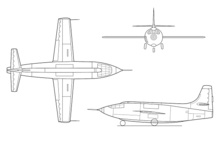
Picture - Three view diagram
General characteristics
Crew: 1
Length: 30 ft 11 in (9.4 m)
Wingspan: 28 ft (8.5 m)
Height: 10 ft (3.3 m)
Wing area: 130 ft² (12 m²)
Empty weight: 7,000 lb (3,175 kg)
Loaded weight: 12,225 lb (5,545 kg)
Max takeoff weight: 12,250 lb (5,557 kg)
Powerplant: 1x Reaction Motors XLR-11-RM3 liquid fuel rocket, 6,000 lbf (1,500 lbf per chamber) (26.7 kN)
Performance
Maximum speed: 957 mph (Mach 1.26) (1,541 km/h)
Range: 5 minutes (powered endurance)
Service ceiling: 71,900 ft (21,900 m)
Wing loading: 94 lb/ft² (463 kg/m²)
Thrust/weight: 0.49
Specification (Bell X-1E)

Picture - X-1E line drawing
Data from Miller, 2001
General characteristics
Crew: 1
Length: 31 ft (9.4488 m)
Wingspan: 22 ft 10 in (6.9596 m)
Height: 10 ft 10 in (3.3 m)
Wing area: 115 ft² (10.684 m²)
Empty weight: 6,850 lb (3107.107 kg)
Loaded weight: 14,750 lb (6,690.487 kg)
Powerplant: 1x Reaction Motors RMI LR-8-RM-5 rocket, 6,000 lbf (26.7 kN)
Performance
Maximum speed: 1,450 mph (Mach 2.24) (2,333.548 km/h)
Range: 4 minutes 45 seconds ((powered endurance))
Service ceiling: 90,000+ ft (27,432+ m)
Chuck Yeager broke the sound barrier on 14 October 1947 in the Bell X-1.
Mach number
Comparable aircraft
Miles M.52
Bibliography
"Breaking the Sound Barrier." Modern Marvels (TV program). 2003.
Hallion, Dr. Richard P. "Saga of the Rocket Ships." AirEnthusiast Five, November 1977-February 1978. Bromley, Kent, UK: Pilot Press Ltd., 1977.
Miller, Jay. The X-Planes: X-1 to X-45, Hinckley, UK: Midland, 2001. ISBN 1-85780-109-1.
Pisano, Dominick A., R. Robert van der Linden and Frank H. Winter. Chuck Yeager and the Bell X-1: Breaking the Sound Barrier. Washington, DC: Smithsonian National Air and Space Museum (in association with Abrams, New York), 2006. ISBN 0-8109-5535-0.
Winchester, Jim. "Bell X-1." Concept Aircraft: Prototypes, X-Planes and Experimental Aircraft (The Aviation Factfile). Kent, UK: Grange Books plc, 2005. ISBN 1-84013-309-2.
Wolfe. Tom. The Right Stuff. New York: Farrar, Straus and Giroux, 1979. ISBN 0-374-25033-2.
Yeager, Chuck, Bob Cardenas, Bob Hoover, Jack Russell and James Young. The Quest for Mach One: A First-Person Account of Breaking the Sound Barrier. New York: Penguin Studio, 1997. ISBN 0-670-87460-4.
Yeager, Chuck and Leo Janos. Yeager: An Autobiography. New York: Bantam, 1986. ISBN 0-553-25674-2.
Living Warbirds: The best warbirds DVD series.
Source: WikiPedia